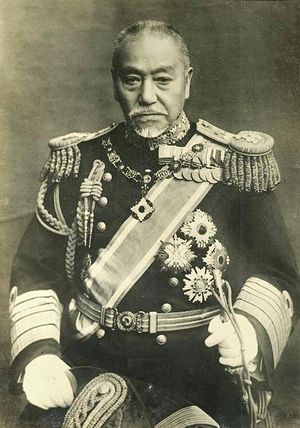
Heihachiro Togo - Admiral of two eras
A famous painting by Tojo Shotaro titled "On the Mikasa Bridge". In the center of adm. Togo, on the left, behind the compass, covered with hammocks (when folded, they served as anti-fragmentation protection), the commander of the ship, Commander Idzhichi, next to the Chief of Staff of the United Fleet, Cadmium. Kato, right, operations officer, Commander Akiyama. Behind the rangefinder XNUMXth lieutenant. Hasegawa.
The seas around Japan sing with cries of victory and joy the awesome majesty and dignity of the Emperor. Cannons should be treated as sacred […], cannons are the soul of a ship. Heihachiro Togo
Togo was one of those Japanese who were born in a feudal country devoid of any importance and incapable of effectively defending its sovereignty against European colonial powers and the United States. Decades later, with the Togo generation gone out of business, Japan was well on its way to becoming a world power. This was largely due to the admiral and his favorite brainchild - the Imperial Japanese Navy.
Heihachiro Togo was born on January 27, 1848 in the village of Kajima-machi (Satsuma province, Kyushu island - the southernmost part of the "indigenous" Japan), into a middle-class samurai family.
However, the feudal system, personified by the shoguns, who had real power, was on the verge of collapse. Consequently, provinces such as Satsuma, ruled by clans of military aristocracy dependent on the shogun, enjoyed a considerable degree of independence. This was expressed, among other things, in the acquisition of ships abroad. Thus, until 1850, the ruling family in Satsuma organized its own fleet, consisting of several units.
In 1853-1854, when Togo was 5-6 years old, American ships anchored off the coast of Japan. Squadron Leader Commodore Matthew S. Perry demanded that Japan be "open" to the Western world and that imported goods be allowed into its home market. The technical advantage of the aliens forced the shogun to initiate changes aimed at the hasty modernization of the country. The example of neighboring China, brought to its knees by the "white barbarians", gave an additional, very effective, as one might assume, incentive.
At that time, Togo's upbringing did not differ much from the standard of his social class. The boy, like his father, had to be a warrior, a loyal subject of his feudal master. So he received his initial training in swordsmanship and at the age of 8 received his first sword, and then received training in shooting. In 1860, at the age of 12 (the age at which a boy was considered “growing up”), he was appointed a “scriber” (probably an assistant official in the local administration organized by the provincial family). Surviving accounts show that Togo was no different from his peers; he was a physically well-developed child, whose mental abilities can be characterized by the word "average".
The first important events in which Togo took an active part occurred in 1863. After the murder of the British merchant Richardson by soldiers of the Satsuma family (the so-called Namamugi incident) and the refusal of compensation, 5 British ships came under artillery fire on the capital of Kyushu, the city of Kagoshima (August 15-16). Togo, along with his father and two brothers, operated smoothbore frontal guns located in a small coastal fort. The British, despite significant losses of 63 people killed, inflicted heavy losses on the enemy. Was destroyed, including the famous porcelain factory owned by the Satsuma family. It was a shocking experience for the locals.
Despite the losses suffered, the provincial authorities continued to develop the local armed forces, and in 1866 (as mentioned above) the core of the modern navy was created here. Togo and two of his brothers joined the nascent navy. However, he originally served on land in a prestigious guard unit that guarded the imperial palace in Kyoto. This placed him at the center of events when, in 1868, the shogunate collapsed and the empire was restored.
The Meiji era began - enlightened rule. Emperor Matsuhito was 16 years old, 4 years younger than Togo. The monarch, with the support of circles striving for the modernization of the state (primarily relatively strong merchants and part of the aristocracy), carried out reforms that shook the traditional way of life of his subjects. Conservative resistance mounted, eventually leading to a civil war (known in Japanese literature as the Boshi War, i.e. the war to restore the empire).
